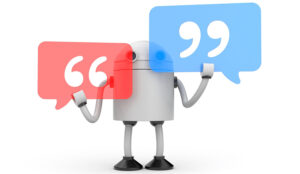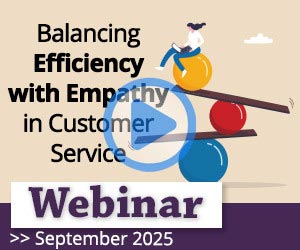81% of UK consumers say contacting a real person is the fastest way to answer their query (Accenture). This principle should be applied to webchat.
So, how can contact centres set their advisors apart from the chatbots? By following these top tips for an improved, humanised webchat service.
1. Get the Greeting Right
Make sure you sound real, rather than robotic, from the off. Think of opening a live chat as you would when approaching a walk-in customer. Keep it natural, be confident, and be sincere.
If it’s an automated greeting, make sure it sounds natural and polite – as if you were talking face to face. “Hello, I’m Anne. How can I help?” is a pretty safe bet.
Don’t go all formal: “Good afternoon, Tamara. My name is Geoffrey and I will be glad to assist you today.” In 2017, hardly anyone speaks like that, so avoid anything that sounds overly formal.
For similar advice, but on the voice channel instead, read our article: Greetings – The Best Way to Greet a Caller
2. Write to You – and Mind Your Ps and Qs
Making advisors aware of the benefit of using personal pronouns is always good advice, as they demonstrate to the customer that the advisor is personally involved and interested in them as an individual. The personal pronoun “you” is a particularly good example:
Be helpful: “What can I do for you?”
Show understanding: “I know what you mean.”
Get ready to sell: “What’s most important to you?”
Remember that every time you say “you”, you’re talking about your customer’s favourite subject.
But you can go one better! Use their name: “I’ll do that right now, Tamara.” Just be careful not to overuse it.
Courtesy will never go out of fashion, particularly in Britain. If you’re asking for information, remember to say “please” and say “thank you”. And, if they thank you, be sure to say “you’re welcome”. Just typing “ok” is the written equivalent of a shrug.
3. Show Empathy and Say Sorry (Sincerely!)

Chatbots might have come a long way, but they can’t show empathy (yet). We humans still have the edge in that department, and it’s one of the things customers value most when they contact a company.
To write with empathy, start by picturing the person you’re chatting to and put yourself in their shoes. If they tell you about something that’s gone wrong, don’t jump straight to the solution – remember to show you understand their situation first.
MAYBE YOUR CUSTOMER IS ABSOLUTELY RAGING AND IT DOESN’T LOOK LIKE THEY’RE COMING OFF CAPS LOCK ANY TIME SOON. The worst thing you can do is offer a customer service cliché like “sincere apologies for any inconvenience caused”. Instead, say “I’m sorry”. Reassure them: “Please try not to worry – I will sort this out for you.”
For more on this topic, read our: 18 Empathy Statements That Help Improve Customer-Agent Rapport
4. BUT, if It’s an Emergency, Sort It out First – Then Do the Empathy Later
If it’s a baking-hot day and there’s been a water mains burst, you could be dealing with a lot of frantic customers. Or a customer is telling you they’ve lost their bank card. Or they’re trying to find out the next flight to Paris because they’ve missed their connection.
Show you understand the situation by acting fast. Get the information you need quickly so you can resolve things ASAP. Being assertive will reassure your customer they’re in safe hands. Then you can show empathy after you’ve dealt with the emergency.
5. Be Direct and Ask the Right Questions
Cut to the chase and get all the information you need quickly. If your customer wants to re-mortgage their home, you’ll need to ask some personal questions.
But there’s no need to beat about the bush with: “Could you tell me whereabouts in the UK the property you’re looking to re-mortgage is based, please?” Just ask: “What’s your address, please?”
6. Take Charge with Active Language

Take ownership for what you’ve done. Being active takes responsibility and shows transparency. No one wants to hear “your bank account was suspended, pending further investigation.” Be open: “We’ve suspended your account while we look into this further.”
Assert yourself with active language: “What I can do for you is…” Can is the key to a world of possibilities: “I can set up a weekly, fortnightly or monthly payment plan.”
Be positive. If the answer’s yes, say it – loud and clear: “Yes, we offer the most competitive payment plan.” Don’t hedge your bets with a hypothetical would. “You would be best to set up the payment plan with us.”
Remember to manage your customer’s expectations and don’t leave them waiting. If looking into their account will take you a couple of minutes, let them know.
To add more positivity into customer interactions, here are our suggestions of: Top 25 Positive Words, Phrases and Empathy Statements
7. Remember It’s a Chat!
To sound conversational, advisors should use contractions, such as: “you’re right”, “I’m sorry”, “that’s great”. If contractions are not used, there is a danger you will sound like a robot. (Read that last sentence aloud and you’ll see what we mean.)
Don’t use jargon. Prioritise your customer’s experience over your process and describe everything you’re doing in plain English. So, if you’re sending someone out to take a look at the fault on their telephone line – say just that. Not “I’ve raised a job to scope the works.”
Use conversational phrases. If you’re helping a customer keep their bills down, “keep an eye on what you use“, don’t talk down to them and “monitor your consumption.” Never “investigate” anything! Say you’ll “look into it.”
Old-fashioned language really stands out in live chats. Words like “may”, “wish” and “whilst” belong in the past. Use everyday words instead, like “might”, “want” and “while”.
For more phrases to avoid, read our article: 11 Things a Call Centre Agent Should Never Say (But Many Do)
8. Don’t Ramble on
Keep your sentences short; think of 20 words as a maximum. Minimise the back and forth with one idea per sentence. And don’t answer two questions in one message – it’s a sure-fire way to getting your wires crossed.
9. Yes, You Can Use Emojis

A few emojis or emoticons here and there can really bring a chat to life. If you’ve been happy to help a customer resolve an ongoing problem, why not flash them a smile :).
And if your customer cracks a joke, laugh with them: “That’s priceless – love it :’)”
However, there may be some customers who will not be so keen on advisors doing this. So, maybe ask advisors to not do so when interacting with certain customer groups.
But on the whole, if webchat is the customer’s preferred channel, it is more than likely that they will be happy for an advisor to use emojis to personalise the conversation.
Follow the link for our advice on: How to Personalise Customer Interactions
10. Pause Before You Post
They do say that to err is human – but always check before hitting send. Don’t let yourself down with sloppy spelling and typos.
If you carelessly sign off with “your welcome”, you’ll leave your customer questioning your attention to detail.
Thanks to Tamara Carlier, a writing trainer and coach at the The First Word
Find more ideas for providing an improved webchat experience in the contact centre, by reading our articles:
- 15 Golden Rules of Webchat
- 10 Things They Won’t Tell You About Live Chat
- Live Chat Metrics: Which Should You Be Monitoring?
Author: Robyn Coppell
Published On: 17th Jul 2017 - Last modified: 15th Aug 2025
Read more about - Customer Service Strategy, Empathy, Language, Live Chat, Service Strategy







































I’d add two points – firstly, make sure that actually have the resources in place to offer chat when customers want to access it. Research we carried out with retailers found that just 25% of them had it working when tested, despite 43% claiming to offer it. Secondly, arm agents with the knowledge they need to provide accurate answers by giving them access to a centralised knowledge base, so that they can focus on other factors, such as empathy and context.
A really interesting article! I currently manage a team who handle 500+ Live Chats per month from customers. A lot of the article is very much common sense, but I think it is important to mirror the customers tone and language. It also provides a great opportunity to build rapport with the customer and make their experience memorable.